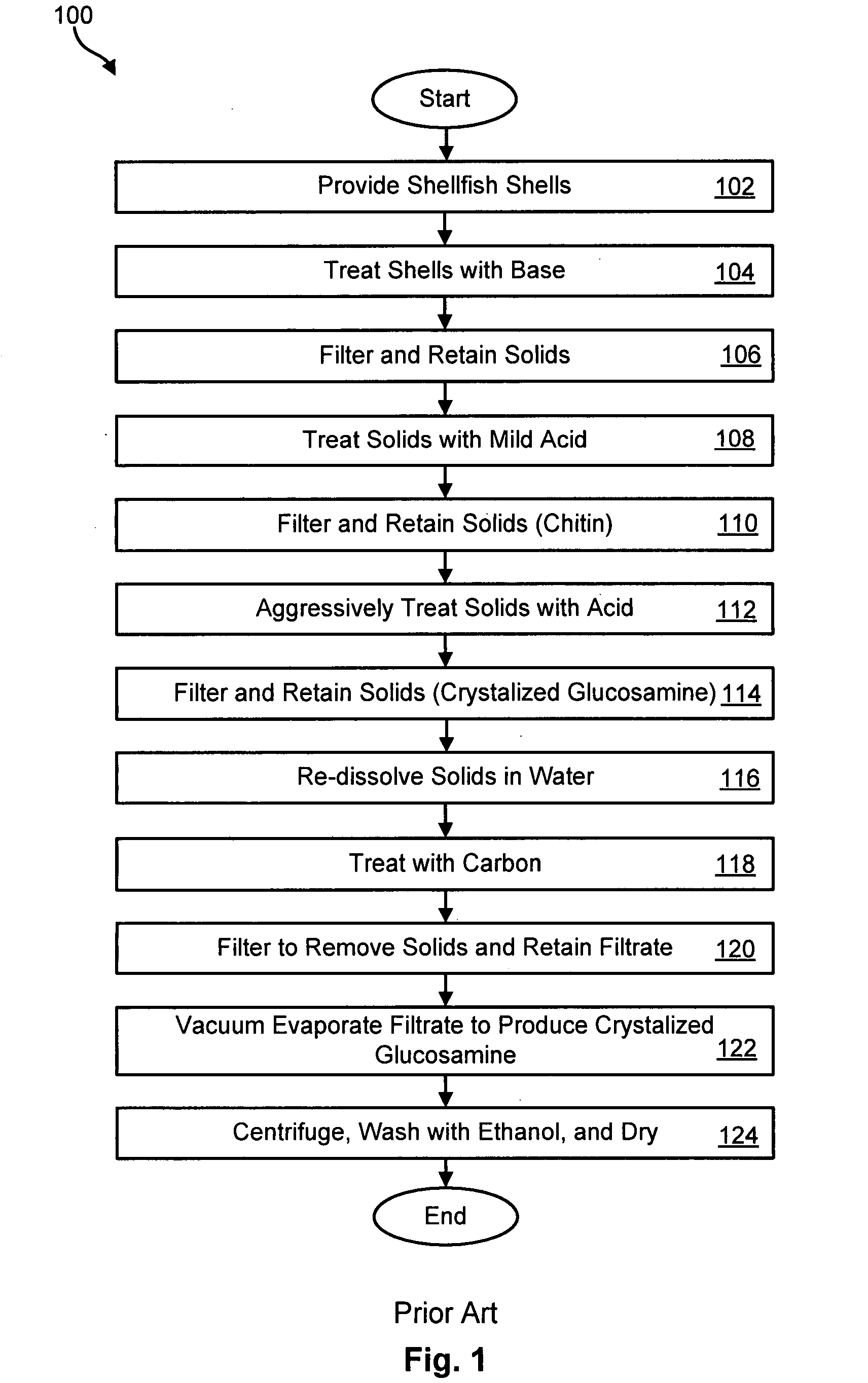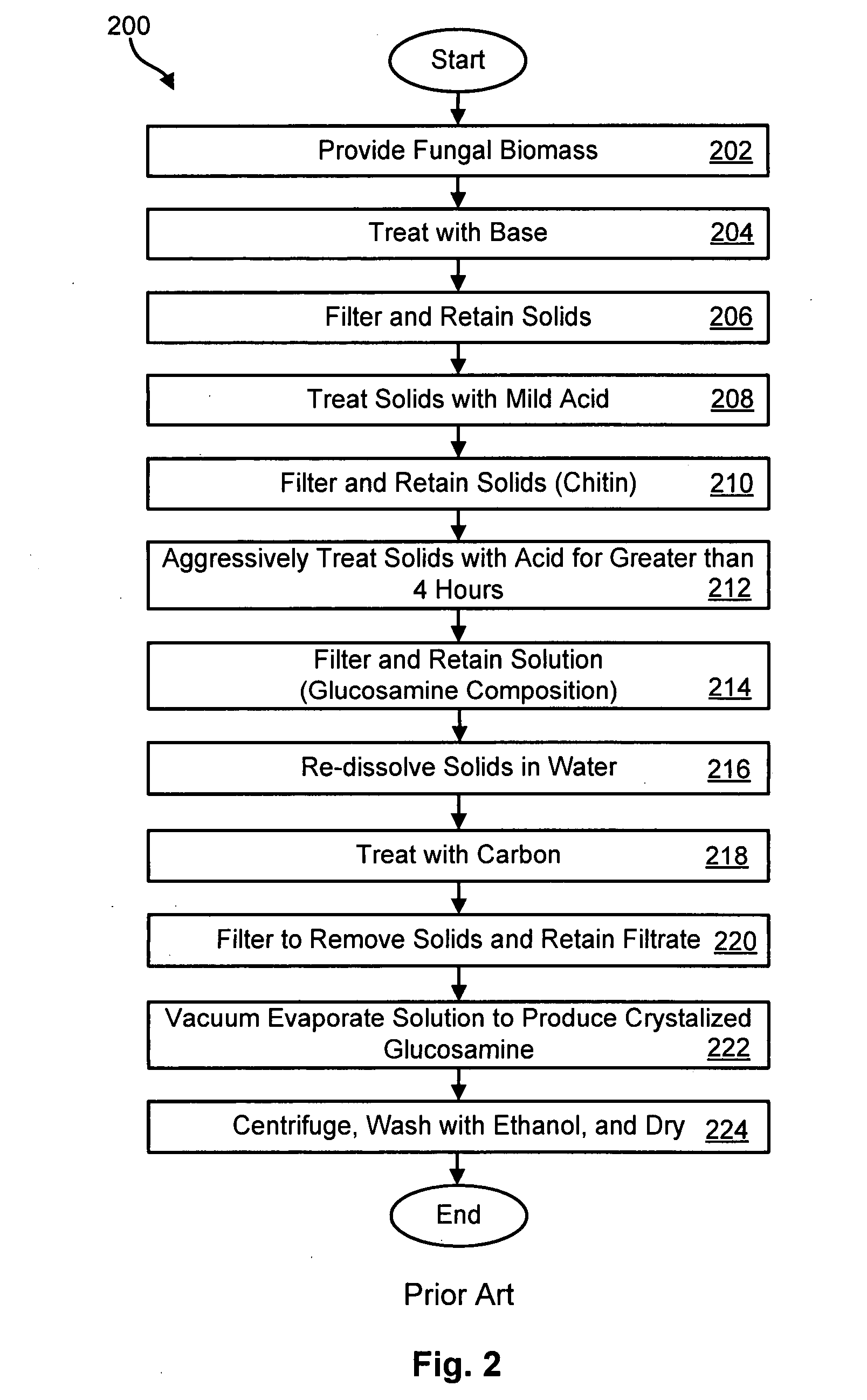Method for producing glucosamine from microbial biomass
a technology of microbial biomass and glucosamine, which is applied in the direction of sugar derivates, organic chemistry, drug compositions, etc., can solve the problems of reducing cartilage flexibility, reducing the level of limiting the production method. , to achieve the effect of reducing ash content and heavy metals and low levels
- Summary
- Abstract
- Description
- Claims
- Application Information
AI Technical Summary
Benefits of technology
Problems solved by technology
Method used
Image
Examples
example i
[0044]Dried citric biomass in the amount of 100 grams was mixed with 250 milliliters of 20% hydrochloric acid (HCl). This mixture was heated at reflux in three experiments at three different temperatures: 60° C., 80° C., and 100° C. Samples were taken at various intervals, and the reaction was analyzed with a high-pressure liquid chromatograph available from Agilent HPLC under the trade name “Agilent 1100.” The results of this reaction are provided in FIG. 4, which provides a graph showing one example of glucosamine production as a function of reaction time and temperature. As shown, the initial 100 grams of dried biomass, which contains approximately 10 grams of chitin, yields approximately 6 grams of glucosamine. This provides a 6% yield relative to the initial 100 grams of dried biomass, or a 60% yield relative to the 10 grams of chitin contained in the dried biomass.
[0045]As can be seen from the graph, the reactions conducted at 80° C. and 100° C. produced a greater yield of glu...
example ii
[0048]Dried citric biomass in the amount of 100 grams was mixed with 300 milliliters of 31% HCl. This mixture was then heated at reflux for 2.5 hours at 100° C. Following the reaction, the mixture was filtered and the filtrate was evaporated to between about 15 milliliters and about 30 milliliters. About 50 milliliters of ethanol was then added to this solution and the mixture swirled to promote precipitation of the glucosamine. The glucosamine precipitates were then filtered from the solution and washed with alcohol. The precipitated glucosamine was then dissolved in water and re-crystallized using the evaporator. The final product provided glucosamine with greater than 98% purity.
example iii
[0049]Dried mushroom in the amount of 100 grams was mixed with 300 milliliters of 31% HCl. This mixture was then heated at reflux for 2.5 hours at 100° C. Following the reaction, the mixture was filtered and the filtrate was evaporated between about 15 milliliters and about 30 milliliters. About 50 milliliters of ethanol was then added to this solution and the mixture swirled to promote precipitation of the glucosamine. The glucosamine precipitates were then filtered from the solution and washed with alcohol. The precipitated glucosamine was then dissolved in water and re-crystallized using the evaporator. The final product provided glucosamine with greater than 98% purity.
PUM
| Property | Measurement | Unit |
|---|---|---|
| Temperature | aaaaa | aaaaa |
| Fraction | aaaaa | aaaaa |
| Fraction | aaaaa | aaaaa |
Abstract
Description
Claims
Application Information
 Login to View More
Login to View More - R&D
- Intellectual Property
- Life Sciences
- Materials
- Tech Scout
- Unparalleled Data Quality
- Higher Quality Content
- 60% Fewer Hallucinations
Browse by: Latest US Patents, China's latest patents, Technical Efficacy Thesaurus, Application Domain, Technology Topic, Popular Technical Reports.
© 2025 PatSnap. All rights reserved.Legal|Privacy policy|Modern Slavery Act Transparency Statement|Sitemap|About US| Contact US: help@patsnap.com



